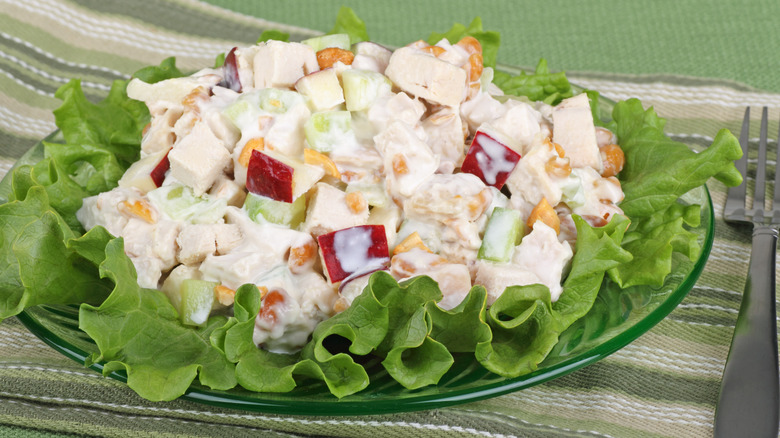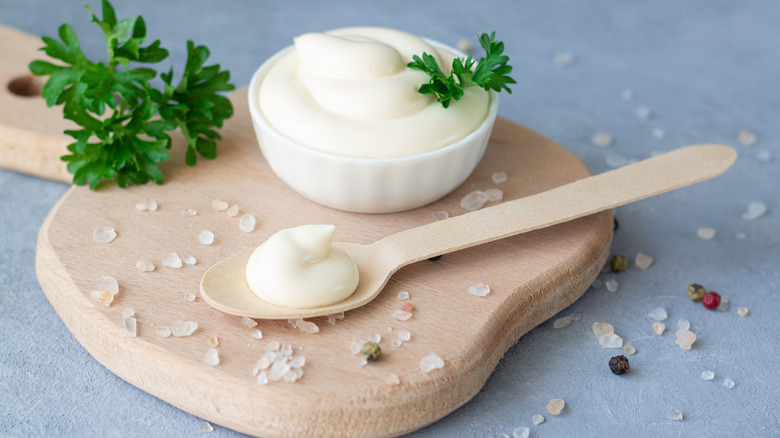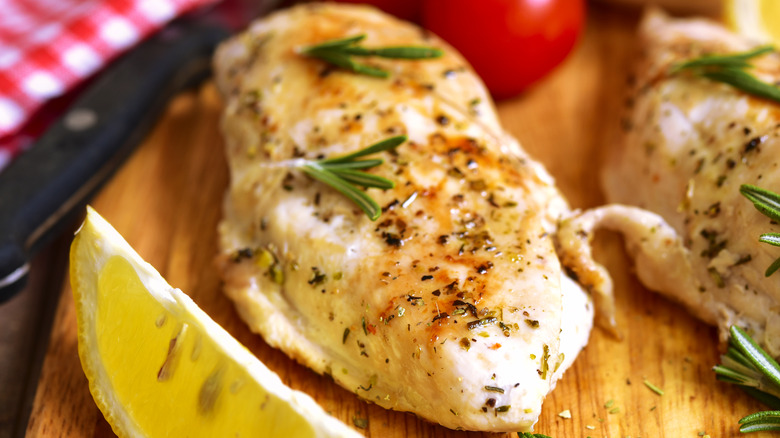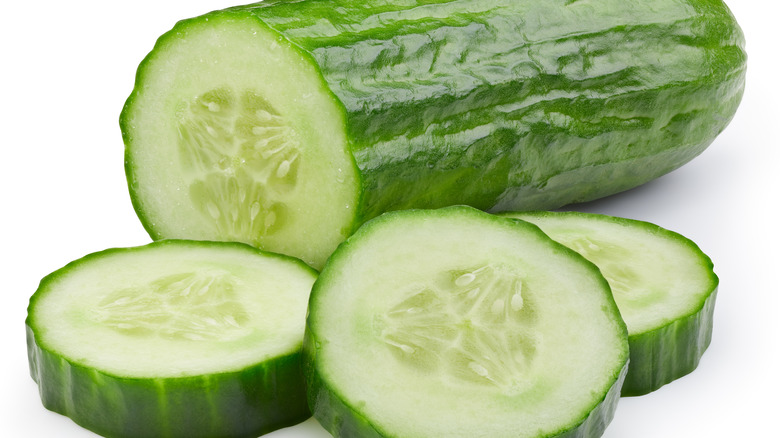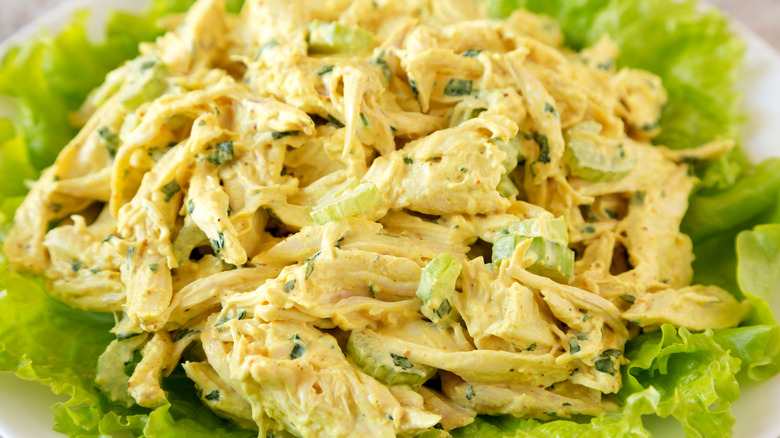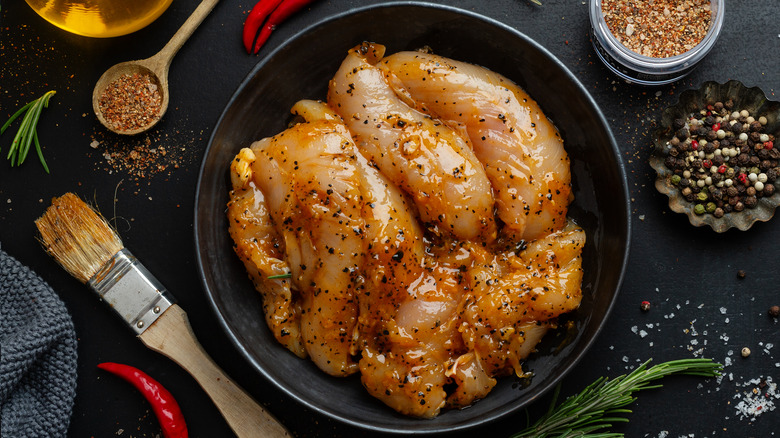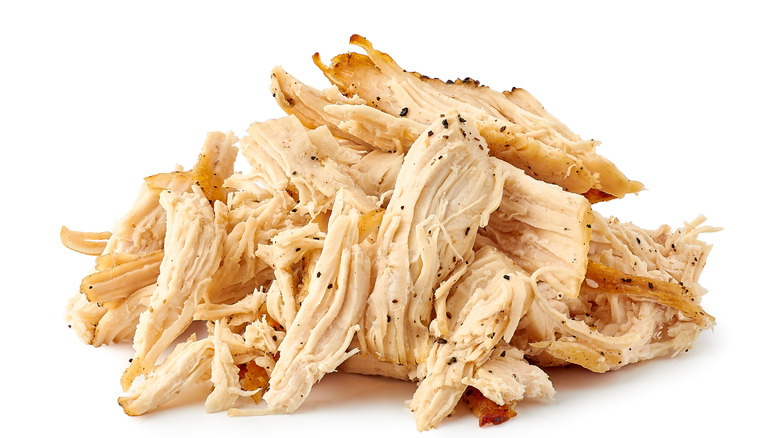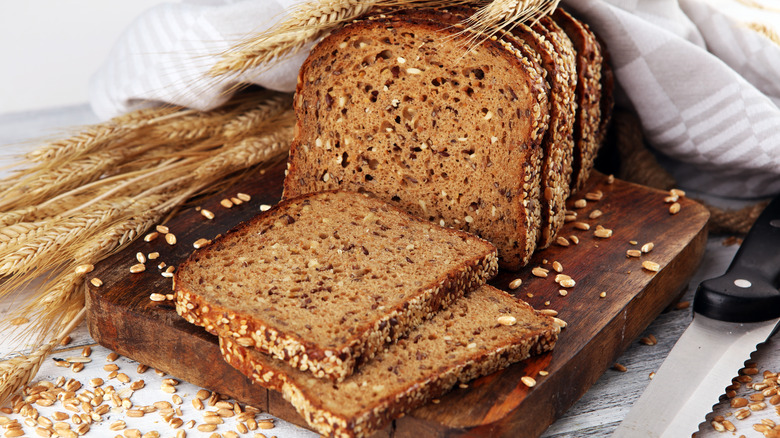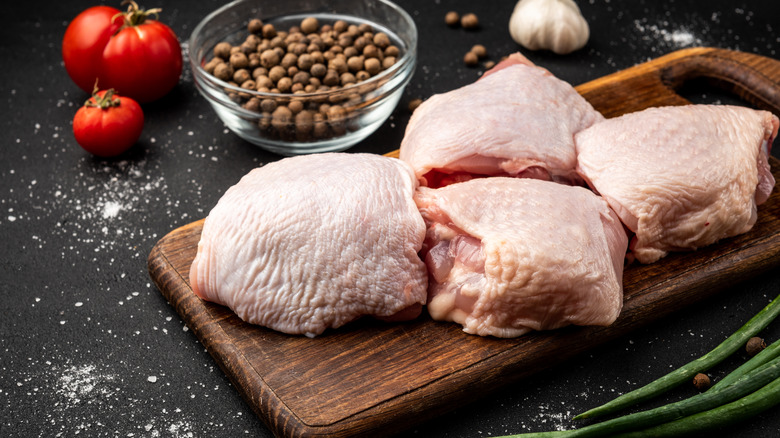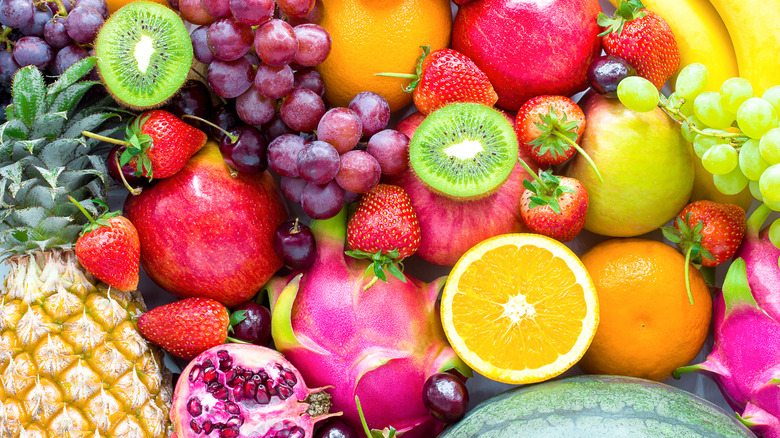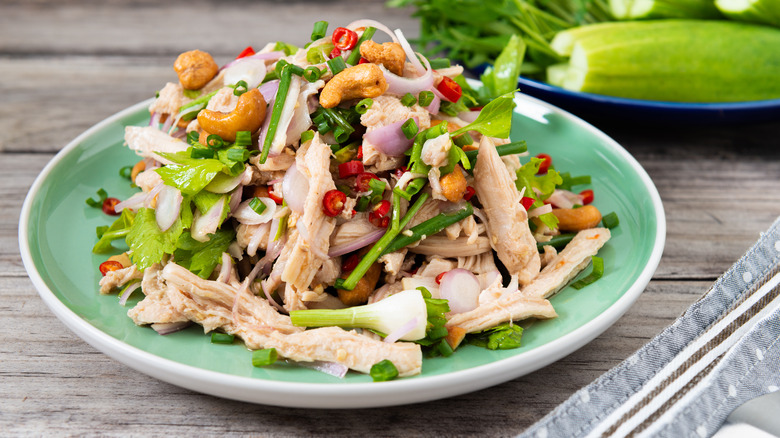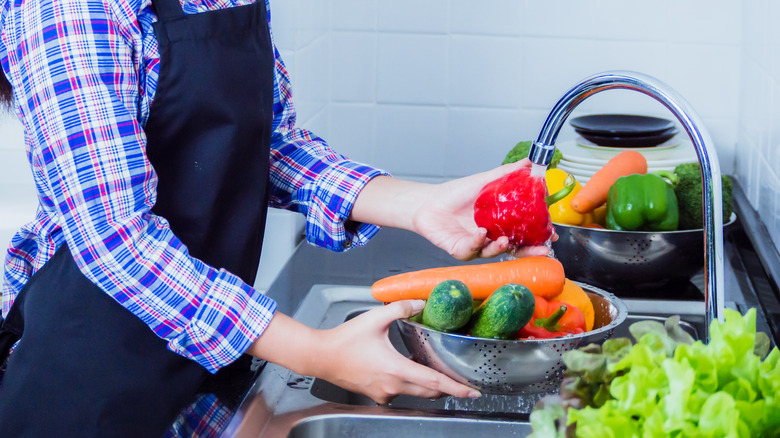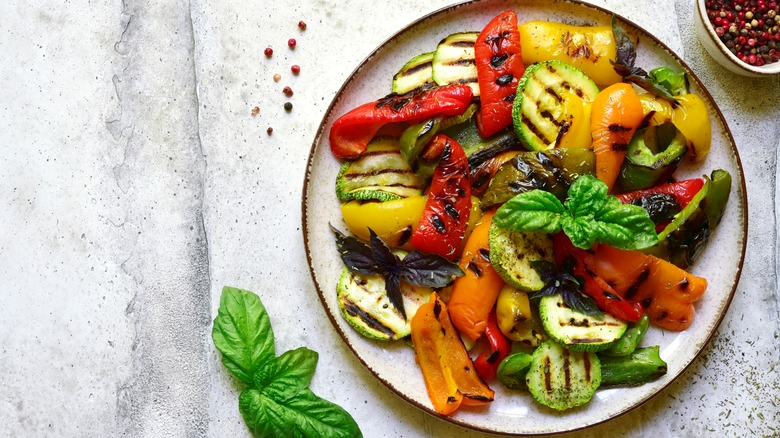The 13 Biggest Mistakes Everyone Makes With Chicken Salad
We may receive a commission on purchases made from links.
The biggest mistakes people make with chicken salad are about flavor, nutrition, and food safety. There's no end to the taste combinations you can create with chicken, a creamy base, a few flavorful ingredients, and the right spices. If you've found yourself in a chicken salad rut or wondering what nutritional mistakes you might be making with your chicken salad, you'll want to read on. You may even find out that you've been pushing your luck with how close you could come to getting food poisoning from unsafe preparation or letting it stay in the fridge for far too long.
We'll explain what you should and shouldn't be putting in your chicken salad, why you sometimes end up with watery salad, and what you should be pairing it with for better nutrition. There's so much that you can do to take a chicken salad from ordinary to extraordinary. Stop making mistakes and start making all the right decisions when it comes to your chicken salads.
1. Adding too much mayo or other creamy salad dressings
When we make chicken salad, it can be tempting to load it up with lots of creamy mayonnaise or other salad dressings. However, not all ingredients that lend creaminess to your chicken salad are created equally. You can end up making a healthy chicken salad extremely unhealthy if you choose high-calorie and high-fat cream bases.
A basic chicken salad recipe calls for ½ cup of mayonnaise. If you eat a serving of basic chicken salad, the mayonnaise portion alone (two tablespoons) will be 188 calories and 20 grams of fat (via Nutrition Value). Meanwhile, the typical creamy dressing contains 126 calories and 13 grams of fat (via Nutrition Value).
You can avoid this chicken salad mistake and make your chicken salad significantly healthier by using less mayo or a different creamy base. For example, you can get plenty of flavor from using sour cream instead, which only has 60 calories and 2.9 grams of fat in two tablespoons (via Nutrition Value). To make it even healthier, try using low-fat yogurt, which has 17 calories and 0.4 grams of fat in two tablespoons (via Nutrition Value).
2. Not using a healthy chicken cooking method
Chicken is a lean type of meat, but not every way you cook chicken will make healthy chicken salad. The best way to keep the calories and fat down is to cook your chicken with a method that requires little to no extra oil, such as grilling, broiling, baking, poaching, boiling, steaming, or microwaving the chicken. Be sure to remove the skin and fat before cooking to reduce fat overall. Meanwhile, using fried chicken for your chicken salad will greatly increase the calorie, fat, and salt content.
According to Healthline, if you cook your chicken using dry cooking methods above 482 Fahrenheit, several studies indicate that the cooking method may create harmful chemicals. They suggest cooking chicken using a method that doesn't brown the meat or produce smoke, such as sous vide, steaming, pressure cooking, or microwaving. On the other hand, cooking methods like grilling, pan-searing, deep-frying, smoking, and roasting may produce carcinogens.
3. Adding too many mushy, watery ingredients to your chicken salad
There's nothing more disappointing than making a beautiful chicken salad and having it ruined by mushy or watery ingredients. Sometimes, you don't notice the problem until you go for leftovers later and notice a pool of liquid on the top of your salad. The biggest offenders for creating a watery salad are raw or cooked watery vegetables or ingredients that have not been dried after you've washed them.
To ensure they're completely dry before adding them to the salad, you will want to pat them with a paper towel or a clean, absorbent dishcloth.
To avoid turning your salad into a soup, you will also want to pay attention to watery veggies like tomatoes, cucumbers, zucchini, and eggplant. A good start with tomatoes and cucumbers is to remove the seeds and soft innards before adding them to the salad. However, Cook's Illustrated suggests going a bit further by salting them to remove excess moisture, especially if you plan to cook these ingredients before putting them in your chicken salad. The salt not only helps to remove excess moisture that can sometimes be trapped in cell walls, but it can also help to release proteins to make the ingredients more flavorful. The method that Cook's Illustrated suggests is to toss the veggies with salt, transfer them to a colander for half an hour, and then dry off the excess moisture before cooking or adding them to the salad.
4. Not adding a variety of ingredients
The chicken salad add-ins you choose have the potential to make your salad even more nutritious. While anything you add increases the overall calorie content of your salad, it can also increase the salad's fiber, vitamin, and mineral content. So, choose your ingredients wisely.
You can get fairly creative with the colors and flavors you add. The most common add-ins are apples, nuts, celery, and grapes. However, you're only limited by what you have at hand to add. There are many ingredients you can put on your salad you may not have considered previously, like olives, seeds, nuts, onions, herbs, apple cider vinegar, pomegranate seeds, and pickles. It's just a matter of pairing them with the right themes. The spices and ingredients you choose can turn an ordinary salad into one with a completely different flavor profile. For example, the Classic Coronation Chicken salad recipe contains cinnamon, ginger, mango chutney, curry powder, sultanas, and cilantro for a nice Indian cuisine flair. Or you could go for an Asian-inspired Crunchy Chicken Salad with ingredients like dry ramen noodles, almonds, Kewpie mayo, cilantro, ginger, rice wine vinegar, and togarashi (a Japanese spice).
5. Not making your chicken salad flavorful enough
Sometimes, making your chicken salad more flavorful is about how you make the chicken. If you start out with chicken that tastes like nothing, it can be difficult to cover up the blandness with external ingredients alone. If you start out marinating, brining, barbecuing, seasoning, or adding citrus while cooking, you can end up with a far more flavorful chicken as a base.
Of course sometimes the whole reason we decide to make chicken into a salad is that we want to do something with bland, boring chicken. You can always gussy up your chicken by drizzling an acid like lemon or pickle juice on it. Stir-ins like spice mixes and herbs can always kick it up a notch. While it's not the healthiest add-in, many people find that almost everything tastes better with a little bacon. Pickled vegetables like cucumbers or peppers can add an extra zing from their vinegar base. Meanwhile, roasted veggies like peppers can add a more robust flavor to the mix. Of course, you can always add fresh, chopped veggies or fresh fruit for more savory or sweet flavor layers. Chutneys or relishes may add extra interest. You can always include even more protein and different umami bites throughout your salad with nuts, hard-boiled eggs, or cheese. And don't forget alliums like onions and garlic for a harder flavor punch.
6. Using rubbery, tough, or dry chicken
According to Greatist, you can avoid rubbery chicken by brining your chicken before cooking it or cooking it using a moist method. Moist cooking methods include steaming, boiling, slow-cooking, braising, and sous vide. Using a meat mallet to tenderize the meat can also help break down the protein and make it more delicious overall.
Of course sometimes your chicken is rubbery because the meat has more connective tissue than normal, which a 2020 study attributes to chickens that grow too quickly. In that case, your cooking method may not be at fault for the tough state of your chicken.
Whether your chicken is too tough or dry because you didn't cook it with moisture, the chicken grew too quickly, or you overcooked it, you can still salvage overcooked chicken. If you cooked chicken on the grill or in the oven, you can often remove the burned outer parts to reveal meat that is still tender inside. Adding olive oil or butter to the chicken may also moisturize it a bit. Sometimes you can rescue dry chicken by warming it up with a little water or other liquid like broth to restore lost moisture.
7. Not pairing it with a good source of fiber
If you've been eating your chicken salad alone or on white bread or plain crackers, you're doing it wrong. The first reason is that they're not as nutritious as other options. But, being low in fiber, they won't fill you up as well either.
When you think about the type of bread or cracker to use, consider a whole-grain option. Whole grains usually have more vitamins and minerals than bread and crackers made from bleached white flour. Insider says that 100% whole wheat bread tends to have three or four grams of fiber rather than just one. It contains B and E vitamins, iron, magnesium, zinc, and antioxidants. Plus, Healthline says the fiber makes it more filling. Another option is to serve it on top of lettuce or with other greens. Lettuce and greens can be a great choice if you're looking for a lower-calorie addition that can add fiber and nutrients to your meal.
8. Not being careful when preparing, storing, and serving chicken salad
Chicken salad has the potential to cause food poisoning if you're not careful about how you prepare, store, and serve it. The CDC says that about a million people in the U.S. get sick from eating bad chicken each year. There are several types of bacteria that can camp out on chicken and make people sick, including Salmonella, Campylobacter, and Clostridium perfringens.
Several things that people do put them in danger of food poisoning, according to the CDC, include allowing raw chicken juice to contaminate other food and not using a different cutting board for raw chicken. You must wash cutting boards, dishes, utensils, sinks, and your hands – for 20 seconds – after they have come in contact with raw chicken.
After you've cooked chicken, be sure to check it with a food thermometer to ensure that it has reached an internal temperature of 165 F, which should kill any pathogens. You'll also want to keep in mind that bacteria starts to grow on food any time it's in the "danger zone" within the range of 40 to 140 degrees Fahrenheit (via USDA). The CDC says that chicken is normally safe out of the refrigerator for two hours. However, if your chicken salad has been sitting around in the hot car or sun at 90 degrees Fahrenheit or above, it's only safe for an hour because the bacteria will have multiplied faster.
9. Only using dried or candied fruit
Chicken salad benefits from the addition of something sweet like fruit, which contrasts with all the savory elements for added flavor interest. There's nothing inherently wrong with adding dried or candied fruit to chicken salad instead of – or in addition to – fresh fruit. However, you should be aware that just a little bit of dried fruit adds more extra calories and sugar than you might think to your salad. If you add a handful of raisins (around ¼ cup) to your salad, you're adding 170 calories and 37 grams of sugar (via Nutrition Value). Whereas if you add a handful of grapes instead, you're only adding 39 calories and 8.8 grams of sugar (via Nutrition Value). The same thing goes for every type of fruit and its dried alternative. Because dried fruit has had the majority of its moisture removed, the fruit is shrunken, which can be deceiving because more calories and sugar can pack into the same amount of space. If you think about the size of an individual raisin in comparison to a grape and think about how many former grapes are making up a handful of raisins, you'll get the idea.
10. Not adding crunchy ingredients to your chicken salad
Just like sweet ingredients can add interest to your chicken salad, so can crunchy ingredients. A variety of textures can make your salad far more interesting. There's a reason why we love crunchy foods, according to science. When we eat it, our brains have evolved to tell us that it's good to eat, unlike mushy and decaying food, and over time, we have come to equate that crunching sound we hear with food safety (via Science ABC). In fact, a 2006 study found that when we're stressed, we gravitate toward foods with bite. People even rate foods as less pleasurable when they don't have any texture. So, if you're not adding satisfying, chewy ingredients to your chicken salad, you're not getting as much from it as you could.
A classic chicken salad with a crunchy twist might contain ingredients like apples, celery, and nuts. Crisp fruits, vegetables, nuts, seeds, dry ramen, and snack foods like sesame sticks can add extra crunch to make you get far more pleasure from your salad than you would if it had none.
11. Not washing fruits and veggies before putting them in chicken salad
When you don't wash raw fruits and vegetables before putting them into your salad, you put yourself at risk for foodborne illnesses from bacteria like Salmonella, E. coli, or Listeria. The CDC says it's only safe to skip washing fruits and veggies if the packaging says that they have been pre-washed. Otherwise, assume that they haven't been washed.
The FDA does not recommend using soaps, detergents, or even commercial produce washes. Instead, just use plain running water. The reason is that produce is porous, and you don't want the soap to pass through the skin to the fruit beneath. If you're overly concerned about food safety (like if you accidentally got raw chicken juice on your produce) you can scrub the produce with a brush or wash it with one part vinegar to three parts water (via NPR).
The CDC says that, even if you plan to peel the fruit or veggie or cut it up with the peel intact, it's important to wash the peel before you peel it or cut it. The reason is that you can pass bacteria from the peel to the knife and then to the flesh of the produce you intend to put in your chicken salad.
12. Only considering raw vegetables for your chicken salad
Raw veggies are what we usually think of adding to our chicken salads. Don't forget that there are other tasty alternatives as well: Roasted, grilled, steamed, dried, pickled, and fermented veggies make excellent additions to a chicken salad.
You may be surprised to find that some vegetables obtain nutritional advantages when you cook them. According to Scientific American, vegetables like carrots, spinach, peppers, cabbage, and asparagus provide more antioxidants when they're cooked than when they're raw. The best options are steaming or boiling. Unfortunately for fried food fans, frying depletes these antioxidants.
A 2002 study shows that carrots end up with more beta-carotene when we cook them. Our bodies use beta-carotene to make Vitamin A, which has a variety of health benefits. Heat also makes the carotenoids in carrots easier for your body to use in protecting your eyes and possibly lowering your risk of cancer (via WebMD). WebMD also explains that steamed broccoli holds onto more glucosinolate (which may protect against some cancers) and that quick-cooked mushrooms may have more antioxidants. Consider salad additions like boiled potatoes, boiled sweet potatoes, roasted red peppers, sun-dried tomatoes, pickled beets, cooked carrots, and more.
Adding fermented vegetables to your chicken salad can also play a role in maintaining gut health. Pickles (made with salt rather than vinegar), sauerkraut, kimchi, and other pickled vegetables are great contenders for additions to your chicken salad (via UMass Chan Medical School).
13. Not throwing chicken salad out after three to four days
A lot of people really push their luck when it comes to leftovers, but this is a chicken salad mistake you definitely want to avoid. Just doing a look and sniff test can leave you with food poisoning because you can't see and smell every food contaminant. Leftovers that contain meat are tricky but especially those you won't be reheating before eating. And chicken isn't safe as long as some other meats like beef, pork, and lamb (via USDA).
So, how long does chicken salad actually last? According to FoodSafety.gov, you can keep chicken salad safe in the refrigerator for three to four days at a temperature of 40 degrees Fahrenheit or below. The USDA says it's good for up to five days, but you shouldn't try to push your luck to six days or beyond. Unfortunately, chicken salad doesn't freeze well, and the USDA says you shouldn't freeze it if it contains mayonnaise. While mayonnaise is safe to eat after it's been frozen, the emulsion effect will break down, causing parts of the mayonnaise to separate from its colloidal state (via Southern Living).
